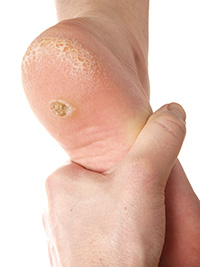With my own children now at school, I find myself spending an increasing part of my time wondering about children’s feet. I cannot emphasise enough the importance of well-fitting shoes for growing kids (important for balance and avoiding strain on growing limbs) and a few years ago I wrote a short article focusing on some of the key issues affecting foot health for children.
Afni Shah-Hamilton – Head podiatrist and owner, Tiptoe Foot Care
The most common reason we see children in the clinic is because of verrucas (or verrucae for those of you who prefer the traditional grammar). That isn’t to say we don’t see a lot of adults with this as well, in fact our hardest cases (and biggest successes) are often in curing adult cases that have been bothering our patients for years. However, verrucas are much more common in children as the skin on their feet is softer (making it easier for the virus to take hold), their immune system is often weaker than adults (especially when they are going through a growth spurt), and they spend more time in bare feet, particularly in the school gym, changing rooms or walking around a swimming pool.
 Whilst some basic cases can cure themselves or be fixed with over the counter medication, it is still very common for cases to last months and I would certainly get any case that’s been around for more than six weeks looked at by a podiatrist. In fact my preference would be for earlier treatment as the verruca will typically work its way deeper into the foot and as it mimics healthy tissue, the body will stop fighting against it. Also, the longer you leave it unresolved, you have more chance of it spreading, perhaps to the other foot or other family members. Once the virus has been in place for three or four weeks, it is unlikely to clear itself.
Whilst some basic cases can cure themselves or be fixed with over the counter medication, it is still very common for cases to last months and I would certainly get any case that’s been around for more than six weeks looked at by a podiatrist. In fact my preference would be for earlier treatment as the verruca will typically work its way deeper into the foot and as it mimics healthy tissue, the body will stop fighting against it. Also, the longer you leave it unresolved, you have more chance of it spreading, perhaps to the other foot or other family members. Once the virus has been in place for three or four weeks, it is unlikely to clear itself.
Whilst there are a number of different techniques for treating verrucas, some are more effective than others. Within our clinic in Barnet we start by identifying which strain of the virus is causing the infection (you may not know there are actually about forty different types of verruca), and then look to find an effective treatment programme. Whilst some podiatrists favour an aggressive approach, we are keen to avoid any scarring in the surrounding area, particularly on children’s feet, and want to minimise stress and pain in the treatment.
Our final area of focus is on education to try and prevent any reoccurrence in future. With that in mind, please make sure if your children have a (suspected) verruca that it is covered up to try and stop it from spreading – not just for sports/swimming but also in the bathroom at home. And when you first discover your child has a verruca, a quick clean with the usual bleach/bathroom cleaners should wipe out any viral cells already on the floor.
In terms of prevention, it’s also worth wearing flip flops or jelly shoes round the pool to minimise the chance of picking up any infections, particularly if you’ve had a verruca before as you will always then be more vulnerable to a further attack.
